年轻的多发性骨髓瘤医疗补助受益人获得治疗的情况。
IF 2.7
4区 医学
Q2 HEMATOLOGY
引用次数: 0
摘要
目的:对于实体瘤患者来说,在癌症确诊前持续享受医疗补助(Medicaid)与更早的发现和更好的治疗效果有关。在本研究中,我们旨在确定在多发性骨髓瘤患者中是否能观察到这一点,多发性骨髓瘤是一种血液肿瘤,没有常规筛查测试,大多数患者是通过急性医疗事件确诊的:这是对 Merative MarketScan 多州医疗补助数据库(Merative MarketScan Multistate Medicaid Database)的分析,该数据库是一个基于索赔的数据集。共有 1105 名年龄小于 65 岁的患者被纳入分析。其中,66%为连续参保(骨髓瘤发生前至少 6 个月参保),34%为非连续参保(骨髓瘤发生前 2-6 个月参保)。使用多变量 Cox 回归估算连续参保状态与指数日期后 1 年内接受骨髓瘤治疗之间的关系:结果:在所有医疗补助参保者中,只有54%的人接受了骨髓瘤治疗,只有12%的人在第一年内接受了干细胞移植。连续参保者接受任何治疗(调整后危险比[aHR]0.59;95%置信区间[CI]0.59-0.70;P < .001)和接受干细胞移植(aHR 0.51;95% CI 0.32-0.81;P = .005)的可能性较低:结论:确诊前持续享受医疗补助的患者接受骨髓瘤治疗的可能性较低。未来的研究应考察连续加入医疗补助计划的骨髓瘤患者是否长期处于经济不稳定和/或医疗需求较高的状态,从而面临更高的治疗障碍。本文章由计算机程序翻译,如有差异,请以英文原文为准。
Treatment Access among Younger Medicaid Beneficiaries with Multiple Myeloma
Purpose
Continuous Medicaid coverage prior to a cancer diagnosis has been associated with earlier detection and better outcomes, for patients with solid tumors. In this study, we aimed to determine if this was observed among patients with multiple myeloma, a hematologic cancer where there are no routine screening tests and most are diagnosed through acute medical events.
Materials and methods
This is an analysis of the Merative MarketScan Multistate Medicaid Database, a claims-based dataset. In total, 1105 patients < 65 years old were included in the analyses. Among them, 66% had continuous enrollment (at least 6 months enrollment prior to myeloma), and 34% had discontinuous enrollment (2-6 months enrollment prior to myeloma). Multivariable Cox regression was used to estimate the association between continuous enrollment status and receipt of myeloma treatment within 1 year of index date.
Results
Only 54% of all Medicaid enrollees received myeloma therapy and only 12% received stem cell transplant within the 1st year. Those with continuous enrollment were less likely to receive any treatment (adjusted hazard ratio [aHR] 0.59; 95% confidence interval [CI] 0.59-0.70; P < .001) and to receive stem cell transplant (aHR 0.51; 95% CI 0.32-0.81; P = .005).
Conclusion
Patients with continuous Medicaid coverage prior to diagnosis were less likely to receive myeloma therapy. Future studies should examine whether myeloma patients with continuous Medicaid enrollment have more chronic financial instability and/or higher medical needs and, thus, have higher barriers to care.
求助全文
通过发布文献求助,成功后即可免费获取论文全文。
去求助
来源期刊

Clinical Lymphoma, Myeloma & Leukemia
ONCOLOGY-HEMATOLOGY
CiteScore
2.70
自引率
3.70%
发文量
1606
审稿时长
26 days
期刊介绍:
Clinical Lymphoma, Myeloma & Leukemia is a peer-reviewed monthly journal that publishes original articles describing various aspects of clinical and translational research of lymphoma, myeloma and leukemia. Clinical Lymphoma, Myeloma & Leukemia is devoted to articles on detection, diagnosis, prevention, and treatment of lymphoma, myeloma, leukemia and related disorders including macroglobulinemia, amyloidosis, and plasma-cell dyscrasias. The main emphasis is on recent scientific developments in all areas related to lymphoma, myeloma and leukemia. Specific areas of interest include clinical research and mechanistic approaches; drug sensitivity and resistance; gene and antisense therapy; pathology, markers, and prognostic indicators; chemoprevention strategies; multimodality therapy; and integration of various approaches.
 求助内容:
求助内容: 应助结果提醒方式:
应助结果提醒方式:


